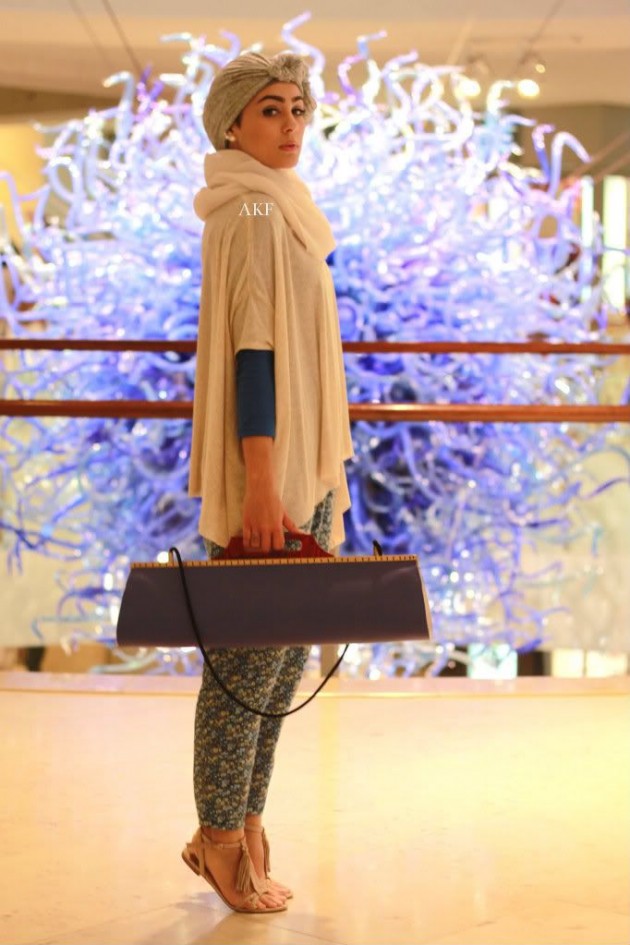A few days ago, an H&M poster made the headlines. For the first time, the worldwide clothing chain showed a veiled woman in the person of the model, Maria Hidrissi. It had nothing to do with a photo shoot for a new collection but a very beautiful video about recycling. Going along with its eco-responsible line “ReCreated Denim” made from biologically recycled cotton, the brand decided to bring the diversity and creativity of its clientele to the forefront. It’s a short film that deconstructs fashion dictates and shows that a woman can wear a skirt after 40, dress like a man and be sexy, distinguish herself from the pack by mixing improbable colors, wear a veil and be chic. Unknowns (and Iggy Pop!) of all kinds, all religions, are showing us their commitment to a responsible fashion.
Greeted by many Muslims who were glad to see a positive image of the veil or denounced by those who refuse to accept this religious sign in public, the Swedish poster left no one indifferent. The message is clear: Be what you are, free to wear what you like and supportive of a cause that sees beyond controversy…
H&M, as have many others, understood that numerous Muslim women, have fashion sense and there is no reason not to cater to this demanding clientele. The Spanish giants, Mango and Zara, recently launched collections aimed at veiled women. Special collections adapted to the specific tastes of their clients by geographic zone is nothing new for these fast-fashion brands try to maintain their monopolies in the four corners of the earth. The items found in Sweden are more sober compared to those more colorful pieces in Italy. Also, during Ramadan 2015, Mango created its first collection of “traditional” dresses for the Muslim woman, called “The ideal guest.”
In 2014, the New York fashion designer Donna Karan also created a collection for the Muslim woman, “The Ramadan Capsule Collection.” Already present in the Middle East in its network of boutiques, the luxury brand affirmed its interest in a growing market and is perhaps inspired the increasing number of these new ultra stylistic Muslim fashion consumers.
In the United States these Muslim fashionistas have been causing talk for a few years. A neologism has even been created: MIPSTERZ from Muslims + hipsters. A 2013 YouTube video documented their debut. To the sound of Jay-Z’s Somewhere in America, veiled young women usual associated with submission and austerity break those clichés. Draped in multicolored veils, mounted on high heels, perched on their skateboards, dancing and jumping in the streets or riding motorcycles, these young women finally embody the ordinary face of an American youth in its time.
On their Facebook page, the Mipsterz profess a real philosophy of life, bringing together religion, art and a political aspiration of social equality.
From now on, these fashionistas who want to reconcile their faith and their taste for fashion, have their own icons. Among them is the young American journalist, Noor Tagoori, picked up by the Oprah Winfrey Network and seen in France on the Grand Journal when visiting, at the invitation of the Collective Against Islamophobia.
In Senegal, the national channel RTS, TV personality, Oumy Ndour is a familiar face for her audience, who have dubbed her “the hip veil”. On social media, the London designer Dina Torika, a.k.a. Dina Toki-O, rules the roost with 650,000 Instagram followers. Another Instagram star is Yaz the Spaz, Cuban and Turkish, living in Florida, he has close to 140,000 followers. France is not left out. In 2008, two sisters, Khadijah and Mariame Tighanimine launced, Hijab and the City, a lifestyle website that proclaims, “you can’t tell a Muslim by her outfit.: The site is defunct but its successor is looming creatively.
In spite of their success, these women, mostly young and unpretentious, do not have the unanimous support of their religious community. Some Muslims accuse them of lacking in sobriety, supposedly contrary to Koranic principles. But the Mipsterz don’t really care and choose to ignore the haters. They affirm themselves with style.
The Youtubers, bloggers and other veiled Muslim fashionistas have nothing to envy in Olivia Palermo and other It-girls of the fashion world. Often at the forefront of trends, using humor and tongue-in-cheek, they mix the hijab or traditional clothing with ultra girly Istagram looks. Just like Nadira Abdul Quddus, designer and successful Youtuber, these girls are true style pros. They are followed by hundreds of thousands and have become style-setters for a new genre of Muslim woman.
Gayanée PIERRE * with Rokhaya DIALLO
Many thanks to SainaSix for her beautiful illustrations
Translated by Alberta Wilson
* Gayanée PIERRE is a French fashion professional. She lives and works in Paris. Follow her on Instagram and Twitter.

